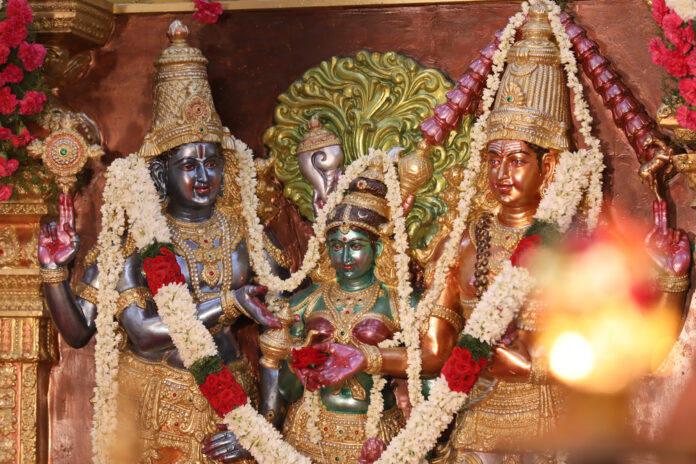Sita Navami 2024
Sita Navami, also known as Janaki Navami, is a significant Hindu festival celebrating the birth of Goddess Sita, the divine consort of Lord Rama. Observed on the ninth day of the Shukla Paksha (waxing phase of the moon) in the month of Vaishakha, Sita Navami holds great importance in the Hindu calendar. It is a day of devotion, reverence, and spiritual reflection for millions of Hindus worldwide. Sita Navami 2024 will be celebrated with great enthusiasm and devotion, offering an opportunity for devotees to remember and honor the virtues and life of Goddess Sita.
Also Read: Ayodhya Ram Mandir – History, Timings, How to Reach
Significance of Sita Navami 2024
- Birth of Goddess Sita: Sita Navami marks the birth of Goddess Sita, an incarnation of Goddess Lakshmi and the epitome of virtue, devotion, and courage.
- Cultural Importance: The festival highlights the cultural heritage and values depicted in the Ramayana, emphasizing the ideals of dharma (righteousness), loyalty, and resilience.
- Devotional Practices: Devotees engage in various religious activities such as fasting, praying, and reading the Ramayana, especially the episodes relating to Sita’s life.
- Community Celebrations: Temples and communities organize special events, including Sita Kalyanam (marriage of Sita and Rama), bhajans (devotional songs), and discourses on the Ramayana.
Sita Navami History
The history of Sita Navami is deeply rooted in the epic Ramayana, which narrates the life and deeds of Lord Rama and Goddess Sita. The story of Sita Navami revolves around the miraculous birth of Sita and her extraordinary life, which serves as a beacon of inspiration for millions.
The Birth of Goddess Sita
- Divine Origins: According to the Ramayana, Sita was discovered in a furrow in a plowed field by King Janaka of Mithila while he was performing a yagna (sacrificial ritual). Believed to be the daughter of the Earth Goddess, Sita is often referred to as the ‘Daughter of the Earth’ or ‘Bhumija.’
- Adoption by King Janaka: King Janaka, the ruler of Mithila, adopted Sita as his daughter and raised her with immense love and care. She was named Sita because she was found in the furrow (Sita in Sanskrit means furrow).
- Marriage to Lord Rama: Sita’s marriage to Lord Rama, the prince of Ayodhya, is one of the central events of the Ramayana. The couple’s life together exemplifies ideal marital values and unwavering devotion to dharma.
Life and Trials of Sita
- Exile and Abduction: Sita’s unwavering loyalty and devotion to Rama are highlighted during their 14-year exile in the forest. Her abduction by the demon king Ravana and subsequent rescue by Rama, with the help of Hanuman and the Vanara army, form the crux of the Ramayana.
- Agni Pariksha: After her rescue, Sita underwent an Agni Pariksha (trial by fire) to prove her chastity and purity, further demonstrating her steadfastness and inner strength.
- Final Years: In the later part of her life, after returning to Ayodhya, Sita chose to leave the palace and live in the forest again, where she gave birth to and raised her twin sons, Lava and Kusha. Her life concluded with her return to the Earth, reaffirming her divine origin.
Sita Navami 2024 Date
Sita Navami 2024 will be observed on Sunday, May 16th. The date is determined based on the lunar calendar and falls on the ninth day of the Shukla Paksha in the month of Vaishakha.
Key Observances and Timings
- Puja Muhurat: The auspicious time for performing Sita Navami 2024 puja and rituals typically starts in the morning and extends through the day. Devotees often consult local Panchang (Hindu calendar) to determine the precise timing.
- Fasting and Vrat: Many devotees observe a strict fast (vrat) on this day, abstaining from food and water until the completion of the puja. Some follow a partial fast, consuming only fruits and milk.
- Rituals and Ceremonies: Special prayers and rituals dedicated to Goddess Sita are performed in homes and temples. Reading the Ramayana, especially the Sita Kalyanam episode, is considered highly meritorious.
Why We Celebrate Sita Navami
Sita Navami 2024 is celebrated to honor the birth and life of Goddess Sita, whose virtues, strength, and devotion serve as a guiding light for millions of devotees. The festival is an occasion to reflect on and imbibe the values exemplified by Sita.
Symbol of Purity and Devotion
- Embodying Virtue: Goddess Sita is revered for her purity, loyalty, and unwavering commitment to dharma. Her life story, filled with trials and tribulations, is a testament to her resilience and inner strength.
- Role Model: Sita is considered an ideal role model for women, epitomizing the qualities of patience, endurance, and moral integrity. Her life inspires individuals to uphold righteousness and face challenges with grace.
Cultural and Religious Importance
- Preservation of Traditions: Celebrating Sita Navami helps preserve and promote Hinduism’s rich cultural and religious traditions. It connects devotees with the timeless values depicted in the Ramayana.
- Community Bonding: The festival fosters a sense of community and togetherness as people come together to celebrate and participate in rituals, prayers, and cultural programs.
Spiritual Significance
- Path to Devotion: Sita Navami is a spiritual reflection and devotion occasion. Engaging in prayers, fasting, and reading scriptures enhances spiritual growth and brings devotees closer to the divine.
- Seeking Blessings: Devotees seek the blessings of Goddess Sita for prosperity, peace, and well-being. It is believed that worshiping Sita on this day brings harmony and strengthens familial bonds.
Rituals and Celebrations
- Temple Celebrations: Temples dedicated to Lord Rama and Goddess Sita are beautifully decorated, and special pujas are conducted. The atmosphere is filled with the chanting of hymns and the singing of devotional songs.
- Sita Kalyanam: A symbolic re-enactment of the marriage ceremony of Sita and Rama, known as Sita Kalyanam, is performed in many temples and households. This ritual is believed to bring marital bliss and harmony.
- Community Feasts: After the puja and rituals, community feasts (prasad) are organized, where devotees share the sanctified food, reinforcing the spirit of sharing and community bonding.





